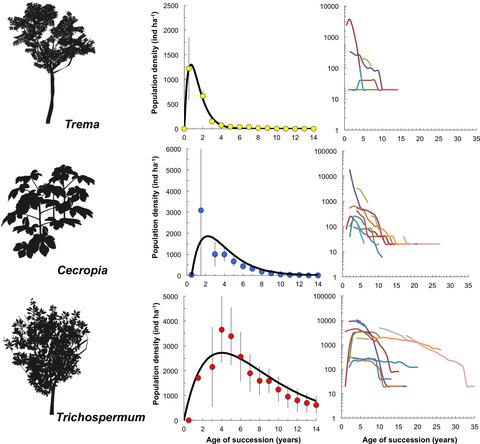Our official English website, www.x-mol.net, welcomes your feedback! (Note: you will need to create a separate account there.)
Demographic differentiation among pioneer tree species during secondary succession of a Neotropical rainforest
Journal of Ecology ( IF 5.3 ) Pub Date : 2021-06-30 , DOI: 10.1111/1365-2745.13738 Miguel Martínez‐Ramos 1 , María del Mar Gallego‐Mahecha 1 , Teresa Valverde 2 , Ernesto Vega 1 , Frans Bongers 3
中文翻译:

新热带雨林次生演替过程中先锋树种的人口差异
更新日期:2021-06-30
Journal of Ecology ( IF 5.3 ) Pub Date : 2021-06-30 , DOI: 10.1111/1365-2745.13738 Miguel Martínez‐Ramos 1 , María del Mar Gallego‐Mahecha 1 , Teresa Valverde 2 , Ernesto Vega 1 , Frans Bongers 3
Affiliation

|
- Early pioneer species share life histories enabling them to colonize disturbed sites, but how much they differ demographically and how such differentiation determines pioneer species turnover during succession are still open questions. Here, we approached these issues by comparing the demography of dominant pioneer tree species during the secondary succession of tropical rainforest in Southeast Mexico.
- We assessed changes in population density, population structure, vital rates and intrinsic population growth rate (r) of the pioneer species Trema micrantha, Cecropia peltata and Trichospermum mexicanum during the first 35 years of succession. For this, we combined chronosequence and long-term (from 2000 to 2018) data from 14 abandoned cornfields with 0.5–35 years fallow age.
- Trema colonized and disappeared first during succession (<15 years), followed by Cecropia (<28) and Trichospermum (>31). All species exhibited hump-shaped successional trajectories of population density and biomass with Trema reaching a peak first, followed by Cecropia and later Trichospermum. Species exhibited a fast reduction in r with fallow age, with Trema reaching negative growth rates (r < 0) in the third, Cecropia in the fourth, and Trichospermum in the seventh year of succession. Recruitment, growth and mortality rates of seedlings and juveniles defined the period of population increase and the age of succession at which each species reached maximum density and biomass. The mortality rate in mature stages determined how long each species persisted during succession. An important variation in species replacement occurred among study sites. In some sites, one species was abundant and the others were almost absent, while it was the opposite in other sites. We inferred that priority inhibitory effects operated among species during the field colonization.
- Synthesis. Although Trema, Cecropia and Trichospermum are considered typical pioneer trees, these species differed importantly in their demographic attributes during succession. The speed at which r declined with age of succession indicated the moment at which each species reached its maximum density and species replacement sequence during succession. However, inter-specific priority inhibitory effects during field colonization may also be involved in the chance of colonization and replacement between species with similar regeneration strategies.
中文翻译:

新热带雨林次生演替过程中先锋树种的人口差异
- 早期先驱物种共享生活史,使它们能够在受干扰的地点定居,但它们在人口统计学上有多大差异以及这种差异如何决定在演替过程中先驱物种的更替仍然是悬而未决的问题。在这里,我们通过比较墨西哥东南部热带雨林次生演替期间主要先锋树种的人口统计学来解决这些问题。
- 我们评估了前 35 年演替过程中先锋物种Trema micrantha、Cecropia peltata和Trichospermum mexicanum 的种群密度、种群结构、生命率和内在种群增长率 ( r ) 的变化。为此,我们结合了 14 个休耕年龄为 0.5-35 年的废弃玉米地的时间序列和长期(2000 年至 2018 年)数据。
- Trema在演替过程中首先定殖和消失(<15 年),其次是Cecropia(<28)和Trichospermum(>31)。表现出人口密度和生物量与驼峰形演替轨迹的所有物种山黄麻第一达到峰值,随后天蚕和后来Trichospermum。随着休耕年龄的增长,物种的r迅速减少,Trema 在第三阶段达到负增长率(r < 0),在第四阶段Cecropia和Trichospermum继位第七年。幼苗和幼苗的补充、生长和死亡率确定了种群增长时期和每个物种达到最大密度和生物量的演替年龄。成熟阶段的死亡率决定了每个物种在演替过程中的持续时间。研究地点之间发生了物种替换的重要变化。在某些地点,一种物种丰富而其他物种几乎不存在,而在其他地点则相反。我们推断,在野外定植期间,优先抑制作用在物种之间起作用。
- 合成。尽管Trema、Cecropia和Trichospermum被认为是典型的先锋树,但这些物种在演替过程中的人口统计特征存在重大差异。r随着演替年龄而下降的速度表明每个物种在演替过程中达到其最大密度和物种更替顺序的时刻。然而,田间定植期间的种间优先抑制作用也可能与具有相似再生策略的物种之间的定植和更替机会有关。












































 京公网安备 11010802027423号
京公网安备 11010802027423号